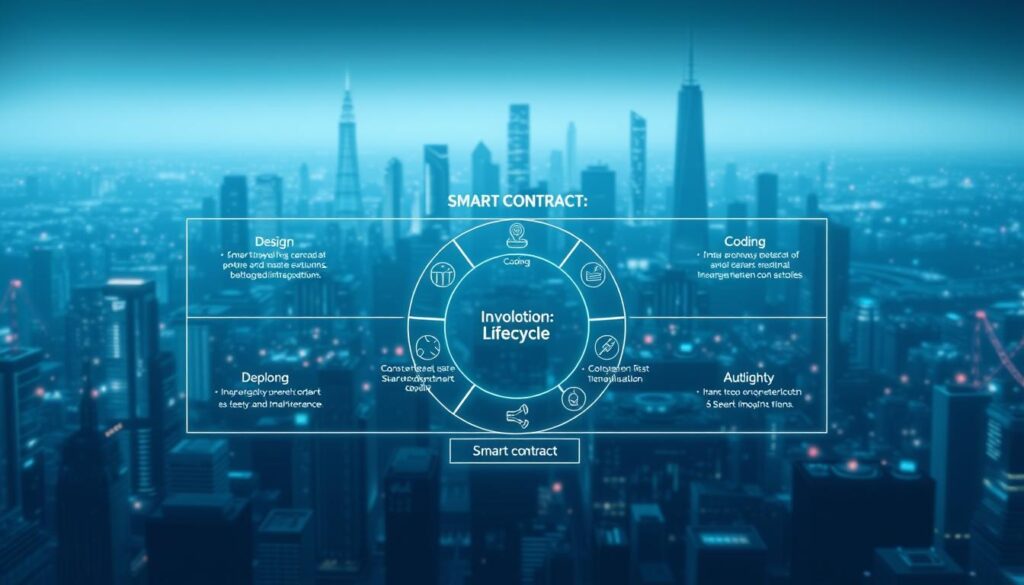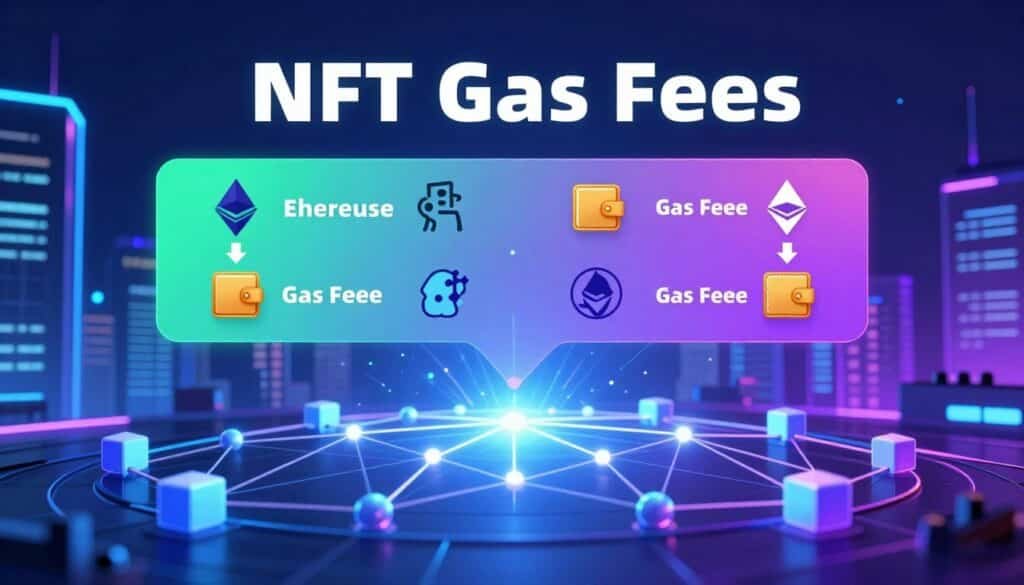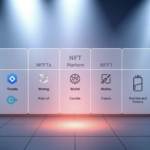Now Reading: NFT Smart Contract Development and Deployment Guide
- 01
NFT Smart Contract Development and Deployment Guide
NFT Smart Contract Development and Deployment Guide

Blockchain-based programs are transforming how we manage ownership in the digital world. These self-executing protocols operate on decentralized networks, activating automatically when specific terms are fulfilled. By removing third-party involvement, they create trustless systems where outcomes are transparent and immediate.
For creators and collectors, this technology unlocks new possibilities. Blockchain ensures data remains unaltered during transactions, providing irrefutable proof of authenticity. This capability makes it ideal for managing rare digital items, from artwork to virtual collectibles.
This resource explains the process of creating blockchain-driven agreements for unique assets. You’ll learn how to structure conditions that trigger automatic actions, maintain security standards, and implement solutions across distributed networks. We focus on practical strategies for establishing reliable ownership frameworks in fast-paced digital markets.
Key Takeaways
- Automated blockchain protocols execute actions without intermediaries
- Immutable transaction records prevent data tampering
- Condition-based triggers enable customized digital agreements
- Decentralized networks ensure transparent asset management
- Security protocols protect against unauthorized modifications
- Ownership verification occurs through cryptographic validation
Introduction to NFT Smart Contracts
Self-executing agreements redefine how we handle unique digital assets. These coded protocols manage ownership rules for virtual items, from artwork to virtual real estate. By embedding specific conditions into blockchain records, they ensure transparent transfers without middlemen.
How Digital Ownership Agreements Work

Digital ownership agreements act as rulebooks for virtual items. They store details like creator royalties, transfer limits, and usage rights. For example, a metaverse land parcel sold through these systems automatically updates ownership records when payment confirms.
Game studios use this technology to let players truly own in-game items. Unlike traditional gaming assets, these digital collectibles remain accessible even if the game shuts down. Players can trade rare swords or skins peer-to-peer, with terms enforced by code.
Blockchain’s Impact on Virtual Asset Management
Distributed ledgers provide tamper-proof transaction histories. Every trade or ownership change gets recorded across thousands of computers. This setup prevents fraud while letting users verify an item’s origin in seconds.
| Feature | Traditional Systems | Blockchain Solutions |
|---|---|---|
| Ownership Proof | Centralized databases | Decentralized validation |
| Transaction Speed | 1-3 business days | 2-5 minutes |
| Fraud Prevention | Manual audits | Cryptographic checks |
| Creator Royalties | Contract negotiations | Automatic payments |
Real estate firms now apply these systems for virtual land sales. When users buy metaverse properties, the agreement instantly registers their claim. This process eliminates title disputes and simplifies cross-border deals.
Understanding Blockchain and Smart Contract Fundamentals
Digital agreements built on distributed networks rely on precise technical frameworks. These systems combine cryptographic security with automated processes to manage transactions reliably. At their core, they operate through predefined rules that execute actions when specific criteria are met.

Core Concepts and Terminology
Every blockchain-driven agreement involves unique components. Gas fees represent the computational power needed to process transactions. These costs vary based on network demand and code complexity.
Developers work with contract addresses to interact with specific agreements. Each action generates a transaction hash, a unique identifier for tracking changes. These elements form the backbone of decentralized applications.
Automation and Trust in Smart Contracts
Automated protocols eliminate manual oversight through conditional logic. When payment confirms, ownership transfers instantly. If delivery deadlines pass, refunds trigger automatically. This precision reduces errors and builds user confidence.
| Feature | Traditional Contracts | Smart Contracts |
|---|---|---|
| Execution | Manual processing | Code-driven automation |
| Dispute Handling | Legal mediation | Predefined resolution methods |
| Modification | Amendments required | Immutable after deployment |
| Operational Cost | Notary/legal fees | Gas fees only |
Trust emerges from cryptographic proofs rather than personal relationships. Network validators verify each transaction, making tampering nearly impossible. This system empowers strangers to collaborate securely across borders.
NFT smart contract development and deployment guide: Step-by-Step Overview
Creating automated blockchain protocols requires careful planning and execution. This six-phase method helps teams transform ideas into functional systems while maintaining security and efficiency. Each stage builds upon the last, ensuring alignment between technical execution and project goals.

Key Stages from Concept to Deployment
Phase 1 starts with defining core objectives. Teams outline ownership rules, transfer conditions, and automated responses. Clear documentation prevents scope creep during later stages.
Platform selection comes next. Developers compare networks like Ethereum and Polygon for speed, fees, and tool compatibility. Ecosystem size matters when considering long-term maintenance needs.
The third phase involves choosing technical resources. Languages like Solidity dominate Ethereum-based projects, while frameworks like Hardhat streamline testing. Prebuilt libraries reduce coding errors for common functions.
Writing actual code forms phase four. Teams implement logic using secure patterns and modular components. Version control systems track changes, allowing easy rollbacks if issues emerge.
Rigorous testing occurs before launch. Developers simulate transactions on test networks, checking for vulnerabilities. Third-party audits often complement internal checks at this stage.
Final deployment makes the system active. Once live, the protocol becomes unchangeable – emphasizing the need for thorough preparation. Network fees and confirmation times vary by platform during this critical step.
Setting Up Your Development Environment
Efficient blockchain solutions start with a properly configured workspace. A streamlined setup accelerates coding workflows while minimizing errors during testing phases. This foundation ensures your tools work seamlessly when handling complex logic.

Installing Hardhat and Node.js Dependencies
Begin by downloading Node.js from its official website. This installs npm, the package manager that handles library installations. Open your terminal and run npm init -y to generate a package.json file in your project’s root directory.
Install Hardhat using npm install --save-dev hardhat. Add essential plugins like hardhat-ethers for blockchain interactions and hardhat-waffle for testing. These components form the backbone of your local environment.
Configuring Your Local Environment and Tools
Create three folders in your file root directory: contracts for code files, scripts for deployment logic, and test for validation checks. Structure prevents chaos as projects grow in complexity.
Edit the hardhat.config.js file to specify compiler versions and network parameters. Set Solidity to version 0.8.0 or higher for optimal security. Configure test networks like Hardhat Network for rapid iteration without gas fees.
Writing and Testing Your Smart Contract Code
Crafting reliable digital agreements demands precision in both design and validation. This phase transforms theoretical concepts into functional systems through structured coding practices and rigorous verification methods.
Developing with Solidity and OpenZeppelin Libraries
Solidity enables developers to build complex logic for blockchain systems. Its inheritance features let teams reuse verified components from OpenZeppelin’s ERC721 templates. These prebuilt contracts handle standard functions like ownership transfers and metadata management.
The ERC721URIStorage approach optimizes storage costs. Instead of storing full metadata on-chain, this method links to external files via URIs. A createToken function might look like this:
function createToken(string memory tokenURI) public returns (uint256) {
_tokenIds.increment();
uint256 newItemId = _tokenIds.current();
_mint(msg.sender, newItemId);
_setTokenURI(newItemId, tokenURI);
return newItemId;
}Conducting Security Audits and Debugging
Three-layer verification ensures system reliability:
| Test Type | Tools Used | Coverage |
|---|---|---|
| Unit Tests | Waffle/Chai | Individual functions |
| Integration | Hardhat Network | Contract interactions |
| Audits | Slither/MythX | Vulnerability scanning |
Run npx hardhat compile after code changes to catch syntax errors early. Third-party auditors examine logic flows for reentrancy risks or overflow scenarios. Automated scanners check for known attack patterns before deployment.
Successful projects balance creative coding with methodical validation. Regular test network simulations help identify edge cases, while version control systems preserve stable iterations.
Deploying Your Smart Contract on Ethereum
Launching digital protocols requires strategic preparation to ensure seamless operation. Test environments let developers simulate real-world conditions before committing to permanent systems. This phase bridges coding efforts and live implementation, where every detail matters.
Using Testnets Like Rinkeby and Goerli
Test networks replicate main blockchain functionality without financial risks. Platforms like Goerli and Sepolia use mock tokens for transaction fees. Developers can trial-run systems repeatedly, identifying bottlenecks before final launch.
These sandbox environments reveal how protocols handle high traffic or unexpected inputs. Teams monitor gas usage patterns and transaction success rates. Fixing issues here prevents costly errors on live chains.
Integrating Alchemy and Infura for Network Access
Node service providers eliminate the need for local blockchain setups. Alchemy offers enhanced APIs for real-time monitoring and error tracking. Infura simplifies connections through reliable endpoints, ensuring consistent uptime.
Configure your hardhat.config.js file with provider credentials and network IDs. Add RPC URLs and wallet details securely. Execute deployment scripts using commands like npx hardhat run scripts/deploy.js --network goerli to activate your protocol.
| Service | Key Feature | Use Case |
|---|---|---|
| Alchemy | Debug tools | Transaction analysis |
| Infura | Scalability | Enterprise deployments |
| Hardhat | Local testing | Rapid iterations |
Gas optimization becomes critical during this stage. Review code for redundant operations and streamline storage calls. Successful deployment returns a unique contract address for blockchain interactions.
Mastering NFT Contract Interaction with Marketplaces
Digital marketplaces bridge creators and collectors through secure transaction protocols. These platforms require specialized integrations to handle unique asset transfers while protecting all parties. Proper setup ensures seamless operations from listing to final sale.
Essential Components for Marketplace Integration
Approval systems form the foundation of marketplace interactions. The setApprovalForAll function grants temporary transfer rights to platform contracts. This enables automatic ownership changes when sales complete, without exposing user wallets.
Security measures like reentrancy guards prevent malicious callback attacks. These modifiers block nested function calls during payment processing. Combined with escrow systems, they create trustless environments for high-value transactions.
| Feature | Fixed Fee Model | Percentage Model |
|---|---|---|
| Listing Cost | Flat network fee | Dynamic commission |
| User Predictability | High | Variable |
| Platform Revenue | Stable | Scalable |
| Best For | Established collections | Fluctuating markets |
Royalty mechanisms automatically route secondary sales proceeds to creators. When implementing this NFT creation tutorial, ensure your contract tracks original ownership. Most platforms deduct fees before distributing remaining funds.
Auction systems require precise bid management and time triggers. Countdown logic must sync with blockchain timestamps, not local devices. Reserve prices should be stored securely to prevent front-running attempts.
Separating marketplace logic from core contracts allows multi-platform compatibility. This modular approach lets creators list assets across venues simultaneously. It also simplifies updates without affecting existing token holdings.
Utilizing Smart Contract Tools and Best Practices
Effective protocol creation hinges on selecting robust tools and proven methodologies. Developers rely on battle-tested frameworks to streamline coding workflows while maintaining security standards. These solutions reduce human error through automation and standardized processes.
Recommended Frameworks and Libraries
Hardhat leads developer preferences due to rapid testing capabilities and extensive plugin support. Unlike older systems like Truffle, it offers real-time error feedback and simplified debugging. Prebuilt templates from OpenZeppelin accelerate coding by handling common functions like access controls.
Key considerations when choosing tools:
- Integration with popular test networks
- Community support and update frequency
- Compatibility with security scanners
Deployment Strategies and Safety Measures
Launching protocols demands careful gas optimization and upgrade planning. Teams use multi-signature wallets to authorize changes, preventing unilateral modifications. Automated audits through tools like Slither detect vulnerabilities before code goes live.
| Strategy | Benefit | Implementation |
|---|---|---|
| Gas Analysis | Cost Reduction | Hardhat Gas Reporter |
| Rollback Plans | Risk Mitigation | Version Control Backups |
| Legal Alignment | Compliance | Jurisdiction Checks |
Version control systems like Git preserve iteration histories, enabling quick recovery from unexpected issues. Regular network simulations on platforms like Goerli test real-world performance under stress conditions.
Real-World Examples and Use Cases for NFT Contracts
Innovative applications across sectors showcase the versatility of blockchain-based agreements. Industries now use automated systems to manage unique assets and streamline complex transactions. These solutions bridge digital innovation with practical needs.
Applications in Gaming, Art, and the Metaverse
Video games demonstrate coded protocols through tradable characters and weapons. Players truly own rare items across platforms, unlike traditional locked ecosystems. Artists benefit from built-in royalty systems, ensuring compensation for resold digital works.
Virtual worlds use these tools for land sales and avatar accessories. Real-world implementations show how digital deeds prevent ownership disputes in metaverse environments.
Case Studies in Real Estate and Supply Chain
Property developers tokenize apartments and parking spots, enabling instant global sales. Each transaction updates automatically on shared ledgers, reducing paperwork delays.
Logistics firms track goods via immutable records. Suppliers prove authenticity at every journey point, building consumer trust. These systems eliminate manual verification in cross-border shipments.















